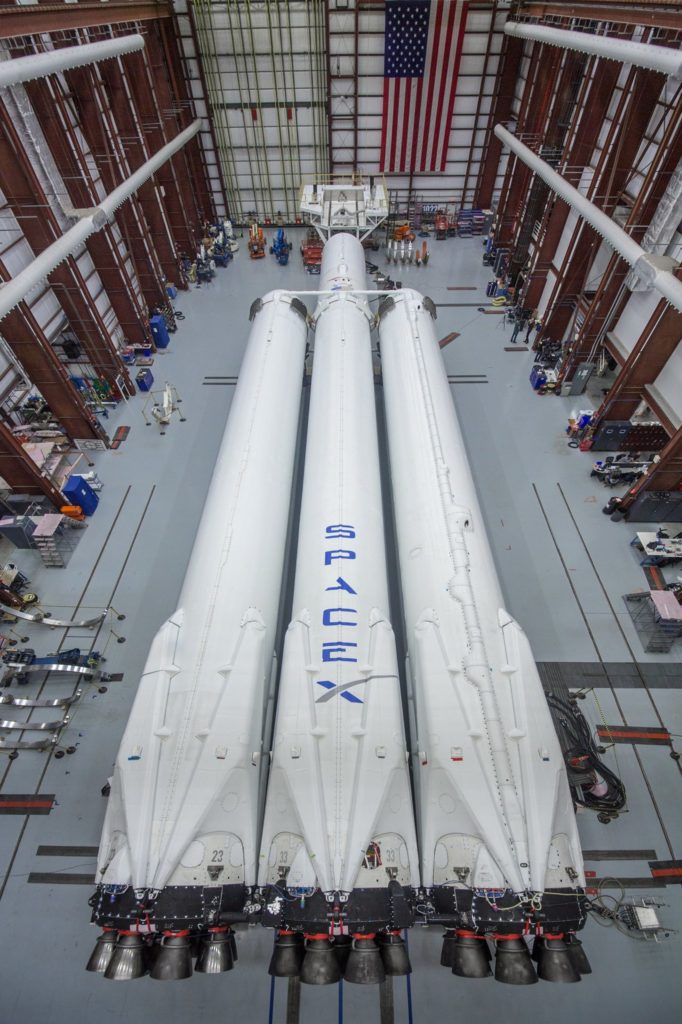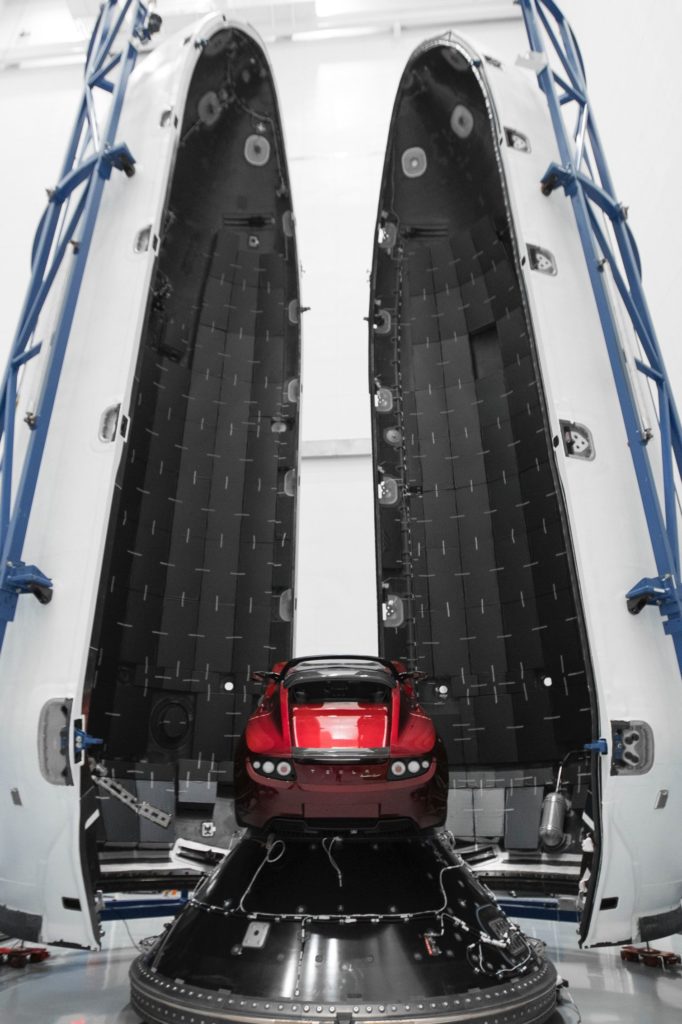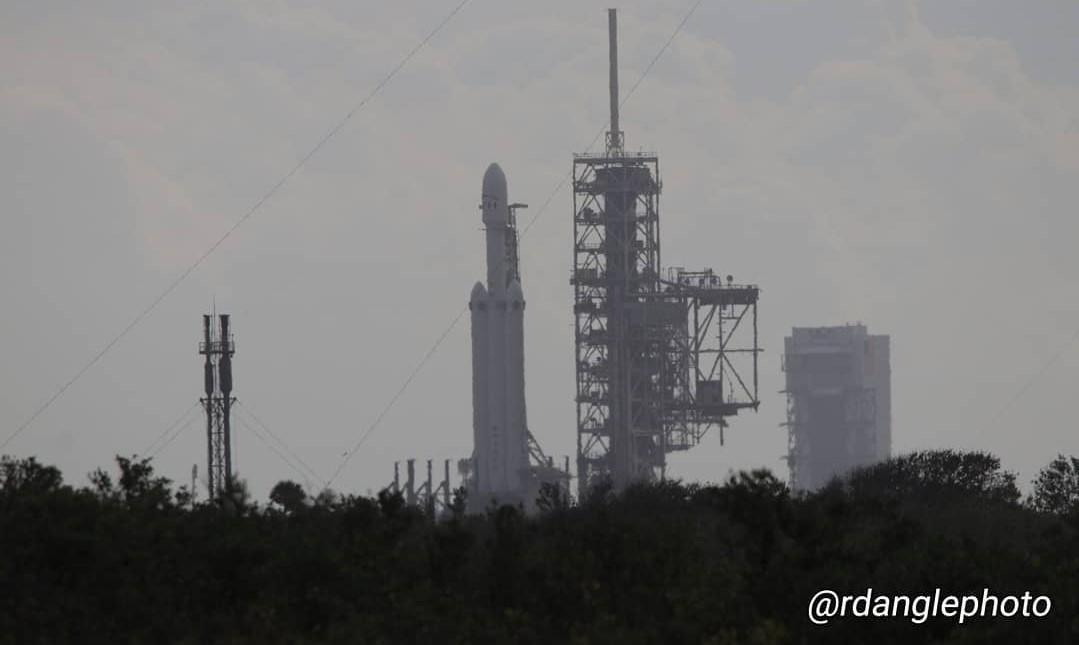

News
SpaceX Falcon Heavy goes vertical with Musk’s Tesla as launch nears
After approximately half a decade of concerted and less-than-patient waiting, long-time followers of SpaceX have, for the first time ever, seen SpaceX’s first completed Falcon Heavy rocket roll out to the launch pad and go vertical at the same complex that hosted every single Apollo moon landing, LC-39A.
This is a historic moment in SpaceX’s history, even if it culminates in nothing more than a quiet rollout and roll-back to the historic pad’s integration facilities. For at least several years, it has been a running (lighthearted) joke within the fan community that Falcon Heavy is permanently six months away from launch. Outside of the rocket company’s supporters, however, that fan humor gained a heavier tinge, and Falcon Heavy essentially became the strawman with which SpaceX detractors could ream the company’s greater (and even relatively minor) ambitions as over-promised, unrealistic dreams to one day also become permanently delayed. While seasoned spaceflight journalists rarely partook in the Falcon Heavy bashing, pop journalism and the titans of the global launch industry certainly took advantage of the apparent weakness as the preeminent example of SpaceX’s tendency towards delays. Even SpaceX’s conservative supporters understandably saw the significance when two customers ultimately chose to move their payloads elsewhere due to Falcon Heavy’s relentless delays.
Falcon Heavy went vertical at LC-39A for the first time today! Here’s a few shots (taken through much haze) from Playalinda Beach. pic.twitter.com/gsOL9tAfTN
— John Kraus (@johnkrausphotos) December 28, 2017
However, the reality was rather clear to those that followed the agile launch company and paid attention to the statements of its executive management, including CEO Elon Musk. Ultimately, Falcon Heavy was not a priority and was only ever going to capitalize upon a minority of the satellite launch industry, given the rarity of satellites heavy enough to need the massive vehicle. While Falcon Heavy would undoubtedly be invaluable for SpaceX’s grander ambitions of interplanetary exploration and transport, those ambitions simply did not compare in importance to solving Falcon 9 design and supply chain issues that caused the failures of CRS-7 and Amos-6. Nor were they more crucial than the launch company’s need for a stable cadre of trusting customers, simply upgrading the already-operational Falcon 9, or the perfection of first stage reusability – all of which would explicitly impact the utility of Falcon Heavy.

A panorama of LC-39A from late-November. Falcon Heavy will likely launch from this pad in January 2018. (Tom Cross/Teslarati)
SpaceX’s official July 2017 confirmation that Red Dragon had been cancelled further guaranteed that Falcon Heavy would only ever be a niche product, maybe even little more than a symbolic stopgap to fill a tiny industry niche and soothe delay-stricken nerves. SpaceX does have at least a handful of Falcon Heavy customers still hopefully awaiting its operational status, but it is quite clear that the company sees its value most as a method of both reassuring the world that its infamous delays are only temporary, as well as relatively economically fueling the development of a reusable super-heavy launch vehicle, expertise that would inevitably benefit the Mars-focused BFR as it too begins development. At a minimum, it will provide SpaceX’s launch, design, and manufacturing experts a sort of base of knowledge about building and operating rockets with ~30 or more first stage engines – the 2017 iteration of BFR is likely to sport 31. It’s also possible that Falcon Heavy could provide the margins necessary to allow SpaceX to attempt recoveries of Falcon’s second stage, a purely experimental effort that would feed directly into the development of the fully-reusable BFR upper stage the company hopes to build, BFS.
Thus, while Falcon Heavy’s inaugural launch may not be explicitly important to SpaceX’s near-term business strategy, it will in almost every way mark one of its first tailor-made steps towards Mars, perhaps both literally and figuratively. Rather humorously, SpaceX (or Elon Musk … probably just Elon Musk) has chosen to replace the boilerplate mass simulator often flown as a payload for inaugural launches of most launch vehicles (Falcon 9 included) with a rather unique mass simulator: Musk’s own first-generation Tesla Roadster. While it has yet to be specified what the specific destination of the second stage and Roadster are, nor what – if any – functional payload is to be included, Musk did suggest that the destination would be a “billion-year Mars orbit.” The nitpick here is hugely significant, as ‘simply’ launching the Roadster into a solar orbit at a similar distance to Mars (still an impressive accomplishment) would be decidedly less impressive than actually injecting the Roadster into orbit around Mars. Pictures released by SpaceX show no additional boost stages attached to the Roadster, so a Martian orbit would require Falcon Heavy’s second stage to coast in deep space for several months while generating enough power to prevent its propellant from freezing and maintain contact with ground control, especially in the rather likely event that SpaceX (and Musk) hope to acquire some rather absurd and iconic images from the inaugural launch and its space travels.
- The first-ever Falcon Heavy (sans payload and fairing) shown inside Pad 39A’s horizontal integration facility (HIF). (SpaceX)
- Elon Musk’s Roadster seen before being encapsulated in Falcon Heavy’s massive payload fairing. Below the Tesla is the payload adapter, which connects it to the rocket. (SpaceX)
- Finally, the fairing is transported vertically to the HIF, where it can be flipped horizontal and attached to its rocket. (Reddit /u/St-Jed-of-Calumet)
History and symbolism aside, it can now be said with utter certainty that Falcon Heavy is very real and is likely to launch very soon. The vehicle’s first-ever integrated rollout to Pad 39A is almost certainly intended only for “fit-checks,” a verification that the pad and brand new vehicle are meshing well together, but it is still the first time in the company’s history that FH visibly exists, and there can be little doubt that the photo opportunity was not taken advantage of. After fit checks are performed, likely over the course of a day or two, Falcon Heavy will be most likely be brought horizontal and rolled back into 39A’s integration facilities, where it will be prepared for its first full-up wet dress rehearsal (WDR) and static fire, possibly including the cautionary removal of the second stage and Roadster payload. Because the vehicle is inherently new, as are many of the upgraded ground systems needed to support it, bugs are highly probable along the road to launch. However, if the first WDR and static fire go precisely as planned, the first launch attempt can be expected to occur about a week later – maybe sooner, maybe later.
All things considered, SpaceX is clearly moving full speed ahead with Falcon Heavy’s launch preparations, and it seems highly probable that the company’s schedule will allow for January launch, even if minor issues mean that multiple WDRs or static fires are required. Elon Musk certainly hedged his bets earlier this summer by aggressively inflating the probability that Falcon Heavy fails on its launch pad, famously stating that a success in his eyes would be the vehicle clearing the pad without destroying LC-39A. In reality, SpaceX would not in a million years haphazardly risk the destruction of Pad 39A, and the company is almost certainly quite confident that the pad is at most marginally at risk of severe damage. One thing that Musk cannot be criticized for is the argument that one way or another, Falcon Heavy’s inaugural launch will be a sight to behold. While the payload may indeed be heading to or towards Mars, SpaceX still plans to attempt recovery of all three of Falcon Heavy’s first stages: both side cores are expected to land almost simultaneously at LZ-1’s two landing pads, while the center booster will follow a parabola out into the Atlantic for a landing aboard the droneship Of Course I Still Love You, truly a spectacle to behold regardless of success or failure.
My capture of @SpaceX #FalconHeavy making her #39A debut today. Taken with my Nikon D3300 with 300mm lens from the Canaveral National Seashore Vista 8. I must admit I have enjoyed watching the reactions to seeing it on the pad. My reaction… WHOA @NASASpaceflight @lorengrush pic.twitter.com/fEntFCwCO8
— Julia Bergeron (@julia_bergeron) December 28, 2017
Follow along live on Twitter and Instagram as our launch photographer Tom Cross documents Falcon Heavy’s last steps along its journey to first flight, as well as Falcon 9’s imminent launch of the mysterious Zuma payload, currently NET January 4.
Cover photo courtesy of spaceflight fan and photographer Richard Angle. Follow him on Instagram at @rdanglephoto!

Cybertruck
Tesla updates Cybertruck owners about key Powershare feature

Tesla is updating Cybertruck owners on its timeline of a massive feature that has yet to ship: Powershare with Powerwall.
Powershare is a bidirectional charging feature exclusive to Cybertruck, which allows the vehicle’s battery to act as a portable power source for homes, appliances, tools, other EVs, and more. It was announced in late 2023 as part of Tesla’s push into vehicle-to-everything energy sharing, and acting as a giant portable charger is the main advantage, as it can provide backup power during outages.
Cybertruck’s Powershare system supports both vehicle-to-load (V2L) and vehicle-to-home (V2H), making it flexible and well-rounded for a variety of applications.
However, even though the feature was promised with Cybertruck, it has yet to be shipped to vehicles. Tesla communicated with owners through email recently regarding Powershare with Powerwall, which essentially has the pickup act as an extended battery.
Powerwall discharge would be prioritized before tapping into the truck’s larger pack.
However, Tesla is still working on getting the feature out to owners, an email said:
“We’re writing to let you know that the Powershare with Powerwall feature is still in development and is now scheduled for release in mid-2026.
This new release date gives us additional time to design and test this feature, ensuring its ability to communicate and optimize energy sharing between your vehicle and many configurations and generations of Powerwall. We are also using this time to develop additional Powershare features that will help us continue to accelerate the world’s transition to sustainable energy.”
Owners have expressed some real disappointment in Tesla’s continuous delays in releasing the feature, as it was expected to be released by late 2024, but now has been pushed back several times to mid-2026, according to the email.
Foundation Series Cybertruck buyers paid extra, expecting the feature to be rolled out with their vehicle upon pickup.
Cybertruck’s Lead Engineer, Wes Morrill, even commented on the holdup:
As a Cybertruck owner who also has Powerwall, I empathize with the disappointed comments.
To their credit, the team has delivered powershare functionality to Cybertruck customers who otherwise have no backup with development of the powershare gateway. As well as those with solar…
— Wes (@wmorrill3) December 12, 2025
He said that “it turned out to be much harder than anticipated to make powershare work seamlessly with existing Powerwalls through existing wall connectors. Two grid-forming devices need to negotiate who will form and who will follow, depending on the state of charge of each, and they need to do this without a network and through multiple generations of hardware, and test and validate this process through rigorous certifications to ensure grid safety.”
It’s nice to see the transparency, but it is justified for some Cybertruck owners to feel like they’ve been bait-and-switched.
News
Tesla’s northernmost Supercharger in North America opens
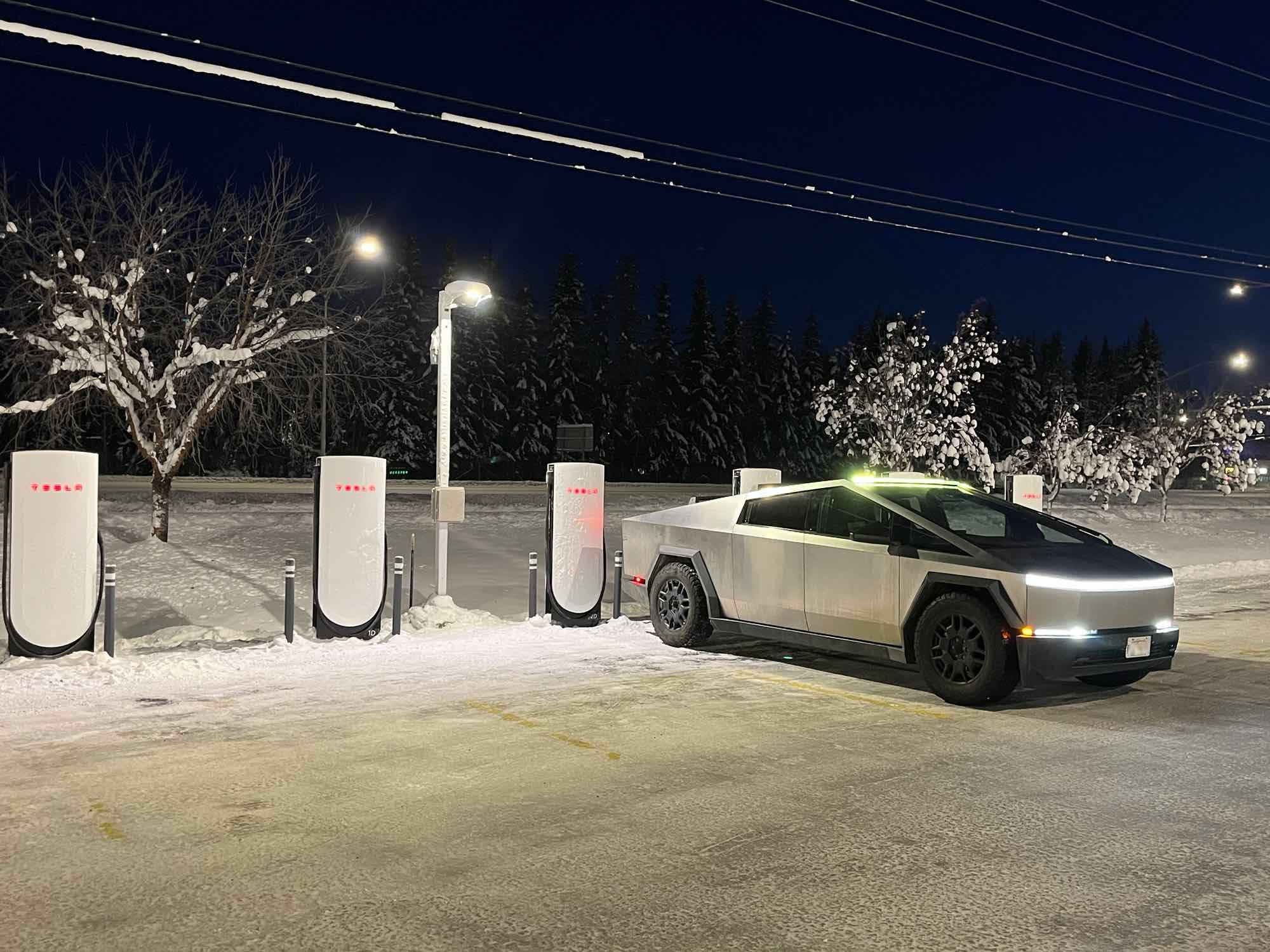
Tesla has opened its northernmost Supercharger in Fairbanks, Alaska, with eight V4 stalls located in one of the most frigid cities in the U.S.
Located just 196 miles from the Arctic Circle, Fairbanks’s average temperature for the week was around -12 degrees Fahrenheit. However, there are plenty of Tesla owners in Alaska who have been waiting for more charging options out in public.
There are only 36 total Supercharger stalls in Alaska, despite being the largest state in the U.S.
Eight Superchargers were added to Fairbanks, which will eventually be a 48-stall station. Tesla announced its activation today:
North America’s northernmost Supercharger Fairbanks, AK (8 stalls) opened to public. https://t.co/M4l04DZ6B5 pic.twitter.com/zyL6bDuA93
— Tesla Charging (@TeslaCharging) December 12, 2025
The base price per kWh is $0.43 at the Fairbanks Supercharger. Thanks to its V4 capabilities, it can charge at speeds up to 325 kW.
Despite being the northernmost Supercharger in North America, it is not even in the Top 5 northernmost Superchargers globally, because Alaska is south of Norway. The northernmost Supercharger is in Honningsvåg, Norway. All of the Top 5 are in the Scandanavian country.
Tesla’s Supercharger expansion in 2025 has been impressive, and although it experienced some early-quarter slowdowns due to V3-to-V4 hardware transitions, it has been the company’s strongest year for deployments.
🚨🚨 Tesla Supercharging had a HUGE year, and they deserve to be recognized.
🍔 Opened Tesla Diner, a drive-in movie theater with awesome, Chef-curated cuisine
🔌 Gave access to Superchargers to several EV makers, including Hyundai, Genesis, Mercedes-Benz, Kia, Lucid, Toyota,… pic.twitter.com/yYT2QEbqoW
— TESLARATI (@Teslarati) December 10, 2025
Through the three quarters of 2025, the company has added 7,753 stations and 73,817 stalls across the world, a 16 percent increase in stations and an 18 percent increase in stalls compared to last year.
Tesla is on track to add over 12,000 stalls for the full year, achieving an average of one new stall every hour, an impressive statistic.
Recently, the company wrapped up construction at its Supercharger Oasis in Lost Hills, California, a 168-stall Supercharger that Tesla Solar Panels completely power. It is the largest Supercharger in the world.
News
Tesla shocks with latest Robotaxi testing move
Why Tesla has chosen to use a couple of Model S units must have a reason; the company is calculated in its engineering and data collection efforts, so this is definitely more than “we just felt like giving our drivers a change of scenery.”
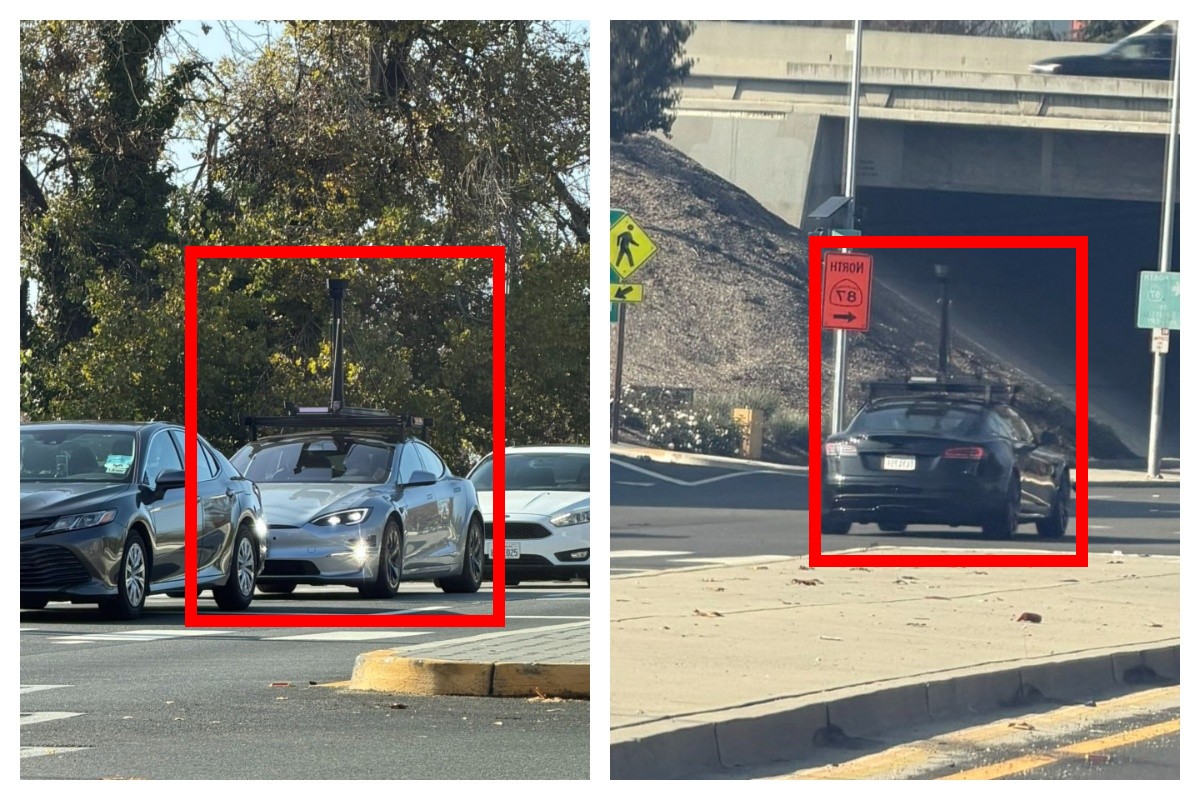
Tesla Model S vehicles were spotted performing validation testing with LiDAR rigs in California today, a pretty big switch-up compared to what we are used to seeing on the roads.
Tesla utilizes the Model Y crossover for its Robotaxi fleet. It is adequately sized, the most popular vehicle in its lineup, and is suitable for a wide variety of applications. It provides enough luxury for a single rider, but enough room for several passengers, if needed.
However, the testing has seemingly expanded to one of Tesla’s premium flagship offerings, as the Model S was spotted with the validation equipment that is seen entirely with Model Y vehicles. We have written several articles on Robotaxi testing mules being spotted across the United States, but this is a first:
🚨 Tesla is using Model S vehicles fitted with LiDAR rigs to validate FSD and Robotaxi, differing from the Model Ys that it uses typically
Those Model Y vehicles have been on the East Coast for some time. These Model S cars were spotted in California https://t.co/CN9Bw5Wma8 pic.twitter.com/UE55hx5mdd
— TESLARATI (@Teslarati) December 11, 2025
Why Tesla has chosen to use a couple of Model S units must have a reason; the company is calculated in its engineering and data collection efforts, so this is definitely more than “we just felt like giving our drivers a change of scenery.”
It seems to hint that Tesla could add a premium, more luxury offering to its Robotaxi platform eventually. Think about it: Uber has Uber Black, Lyft has Lyft Black. These vehicles and services are associated with a more premium cost as they combine luxury models with more catered transportation options.
Tesla could be testing the waters here, and it could be thinking of adding the Model S to its fleet of ride-hailing vehicles.
Reluctant to remove the Model S from its production plans completely despite its low volume contributions to the overall mission of transitioning the world to sustainable energy, the flagship sedan has always meant something. CEO Elon Musk referred to it, along with its sibling Model X, as continuing on production lines due to “sentimental reasons.”
However, its purpose might have been expanded to justify keeping it around, and why not? It is a cozy, premium offering, and it would be great for those who want a little more luxury and are willing to pay a few extra dollars.
Of course, none of this is even close to confirmed. However, it is reasonable to speculate that the Model S could be a potential addition to the Robotaxi fleet. It’s capable of all the same things the Model Y is, but with more luxuriousness, and it could be the perfect addition to the futuristic fleet.
